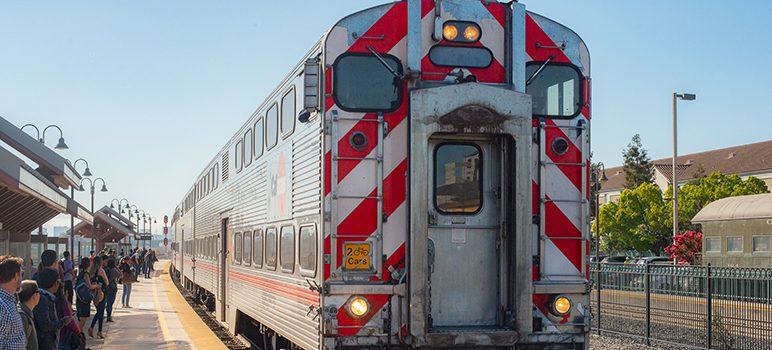The COVID-19 pandemic has put the future of Caltrain in grave danger and it’s now up to Santa Clara and San Francisco counties to save it.
On Tuesday, the Santa Clara County Board of Supervisors will decide whether to place a three-county sales tax on November’s ballot to help fund Caltrain, which has taken a financial hit due to a massive pandemic-related dip in ridership.
But the measure, which would be a one-eight-of-a-percent sales tax, must also be approved by two other Bay Area counties and a number of local transit boards.
San Mateo officials approved the measure way back in April, but the San Francisco Board of Supervisors last week dealt what many thought was the measure’s fatal blow by declining to even take up the issue.
San Francisco supervisors Aaron Peskin and Shamann Walton have long objected to the way Caltrain is governed since the San Mateo County Transit District oversees Caltrain for the three-county Peninsula Corridor Joint Powers Board.
Peskin and Walton argue that the structure has left San Francisco and Santa Clara counties out of the loop when it comes to Caltrain.
On Saturday night, the San Francisco Chronicle broke the news of a new proposal where the money from the sales tax would go back to each county’s transit agency—that would be the Santa Clara Valley Transportation Authority in Santa Clara County’s case. Each agency would then have the power to allocate some or all of the tax dollars to Caltrain.
But following the news, a number of federal, state and local Bay Area elected officials released a statement questioning the proposal’s legality.
“While it’s wildly popular, Caltrain could shut down without its own funding,” Rep. Jackie Speier (D-San Mateo), Rep. Anna Eshoo (D-Palo Alto), State Sen. Jerry Hill (D-San Mateo), State Assm. Kevin Mullin (D-San Mateo), State Assm. Marc Berman (D-Palo Alto), San Mateo County Supervisor Dave Pine and Belmont Vice Mayor Charles Stone said. “To prevent this the legislature passed a statute to allow the public to decide. The statute requires that, if the ballot measure passes, the tax money could go to Caltrain. The proposals by San Francisco and Santa Clara County would violate the statute by making it possible that Caltrain might never see a dime.”
“All of us need to keep riders first and foremost in our minds,” the lawmakers added. “It’s really quite simple. A clean deal is what the riders and public deserve.”
San Jose Mayor Sam Liccardo, who doesn’t serve on the Peninsula Corridor Joint Powers Board, issued a statement Monday calling for regional cooperation to save Caltrain.
“As a Board Member of the Valley Transportation Agency and the Metropolitan Transportation Commission, I have long recognized the importance of Caltrain service to our region and have repeatedly supported efforts to save the service from financial demise,” he said. “I believe we have fashioned—with colleagues in San Francisco and Santa Clara Counties—a viable compromise that addresses the core needs of the agency to operate in the immediate future and to substantially expand service in the future and collaboratively resolve these longstanding disparities in governance.”
“I encourage San Mateo County’s elected and appointed leaders to rise to the collaborative spirit that this moment requires,” the mayor added.
The Santa Clara County Board of Supervisors will discuss the sales tax at its July 21 meeting. The meeting begins at 9:30am and the agenda packet can be found here.


We got enough taxes. Let Google pay for it.
Everything has a shelf life. Caltrain is antiquated and stale. Let it go already. Californians are already taxed to death.
Enough with regressive sales tax measures to fund transit that exists to benefit Big Business (tech and real estate interests).
If anyone ever boards transit willingly again, fund buses. More buses going more places more often. Call them “shuttles” if the word bus is too “of the people” for marketers. Buses benefit the people who live here.
As for pricy, self-serving transit infrastructure projects, let the Big Business beneficiaries pay for it. Leave regular people out of the funding model for fixed rail infrastructure projects.
> If anyone ever boards transit willingly again, fund buses. More buses going more places more often.
Buses make a lot more sense than rail. They’re cheaper, much more flexible, and allow optimizing of the existing roadway infrastructure.
Plus, they are a natural and logical progression toward Elon Musk’s future fleet of robo-taxis.
As a cost cutting measure, combining head offices of Caltrain, BART, VTA, MUNI, SMART and other agencies into ONE makes perfect sense. Keep all bus and rail maintenance yards, operator facilities, customer service centers, and other facilities in tact. Call it BAY METRO, BAY TRANSIT (BT) or whatever else.
I don’t need or ride the train, don’t want to pay taxes to support it.
sales tax, gas taxes, train tax, rail tax, hotel tax, use tax, income tax, construction tax, corporate tax, insurance tax, tobacco tax…
“In 2015-16, taxes in California raised a total of $220 billion—equal to nearly 10 percent of the state economy.”
10% of the state economy… 10%!
https://lao.ca.gov/reports/2018/3805/ca-tax-system-041218.pdf
you voted for it, you got it. Now pay up.